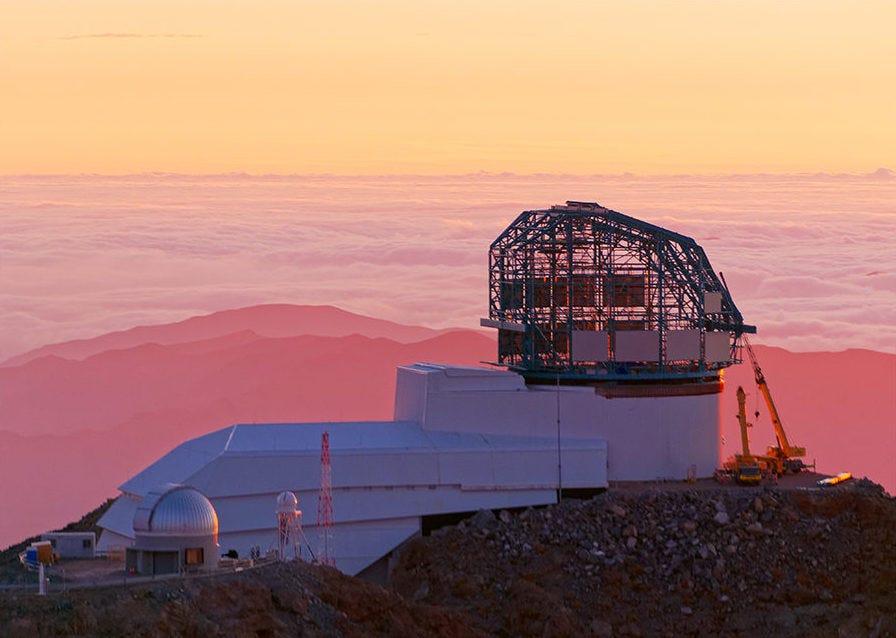A Single Exposure.
100,000 galaxies.
1. MIT Technology Review:
High atop Chile’s 2,700-meter Cerro Pachón, the air is clear and dry, leaving few clouds to block the beautiful view of the stars. It’s here that the Vera C. Rubin Observatory will soon use a car-size 3,200-megapixel digital camera—the largest ever built—to produce a new map of the entire night sky every three days.
Generating 20 terabytes of data per night, Rubin will capture fine details about the solar system, the Milky Way, and the large-scale structure of the cosmos, helping researchers to understand their history and current evolution. It will capture rapidly changing events, including stellar explosions called supernovas, the evisceration of stars by black holes, and the whiz of asteroids overhead. Findings from the observatory will help tease apart fundamental mysteries like the nature of dark matter and dark energy, two phenomena that have not been directly observed but affect how objects in the universe are bound together—and pushed apart.
Rubin is the latest and most advanced entrant into the illustrious lineage of all-sky surveyors—instruments that capture, or survey, the entire sky, over and over again. Its first scientific images are expected later this year. In a single exposure, Rubin will capture 100,000 galaxies, the majority invisible to other instruments. A quarter-century in the making, the observatory is poised to expand our understanding of just about every corner of the universe. (Sources: technologyreview.com, rubinobservatory.org)
(The Vera C. Rubin Observatory, in the final phases of its construction, atop Cerro Pachón in Chile).
2. European scientists have started work on a project to create simple forms of life from scratch in the lab, capitalizing on theoretical and experimental advances in the fast-growing field of synthetic biology. Starting with inanimate chemicals, the researchers aim to produce metabolically active cells that grow, divide and show “Darwinian evolution” within six years. The €13 million “MiniLife” project, which is funded by the European Research Council and involves biologists and chemists from several universities, could be the first in the world to reach the minimum criteria for a synthetic living system. “Success would constitute a landmark achievement in basic science,” said Eörs Szathmáry, director of the Centre for the Conceptual Foundations of Science at the Parmenides Foundation in Germany, who is a principal investigator on the ERC grant. “De-novo creation of living systems is a long-standing dream of humanity.” John Sutherland, who works on the chemistry of early life at the MRC Laboratory of Molecular Biology in Cambridge, said the project joins a growing worldwide effort to “create minimal living systems”. (Source: ft.com)
3. The Economist:
(A) new generation of therapies known as “cancer vaccines” aim to train the immune system to recognize tumors and fight their spread. Trials are now under way against cancers found everywhere from the skin and ovaries to the brain and lungs. After half a century of disappointing dead ends, promising results are starting to emerge.
Cancer can begin from almost any cell in the body. The immune system usually tries to prevent it from spreading by monitoring the body for abnormal cells. White blood cells known as T-cells, for example, attack tumours by recognising foreign proteins known as non-self antigens on their surfaces. So-called natural killer cells and macrophages can also identify and destroy cancerous cells by searching for the unfamiliar molecules they carry, or after they are tagged by antibodies.
If the cells in a cancer evolve to evade the immune system, however, they can then grow, replicate and spread around the body. This outflanking manoeuvre, however, is now offering oncologists new targets for their drugs. When scientists first began to sequence the DNA of tumours, in 2008, they found that cancer cells contained hundreds, if not thousands, of mutations that distinguished them from their healthy neighbours. Some of these mutations in cellular DNA cause cancer cells to produce abnormal proteins, known as neoantigens, which can set the immune system’s alarm bells ringing.
The idea behind a cancer vaccine, then, is to introduce these neoantigens directly into the body, thereby training the immune system to see any cancer that carries them as a foreign body, ripe for elimination. (Source: economist.com)
Keep reading with a 7-day free trial
Subscribe to News Items to keep reading this post and get 7 days of free access to the full post archives.


